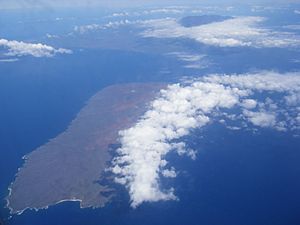Kahoolawe facts for kids
Kahoʻolawe is the smallest of the eight main islands in Hawaii, United States. It is west of Maui and south of Lanaʻi. The island is about 11 miles (18 km) long and 6 miles (10 km) wide. Its highest point, Lua Makika, is 1,477 feet (450 m) above sea level. Kahoʻolawe is quite dry because it is not tall enough to catch much rain from the winds.
Contents
A History of Military Use
For many years, Kahoʻolawe was used by the United States Navy as a target for bombs and gunfire. This started around 1941, during World War II, and continued until May 1994. Many people in Hawaiʻi wanted this bombing to stop. Their efforts eventually led to the Navy stopping its training there.
After the bombing stopped, the Navy began a big cleanup project. They are trying to remove unexploded bombs and shells from the island. These dangerous items are still buried or lying on the ground. Some have even washed into the ocean. In 1981, the entire island was added to the National Register of Historic Places because of its important history and culture.
Returning the Island to Hawaiians
The plan is to give Kahoʻolawe back to the Hawaiian people. In 1993, the U.S. Congress passed a law about the island. This law said that Kahoʻolawe was culturally important. It also required the Navy to return the island to the State of Hawaii. The law also directed the Navy to clean up all the unexploded bombs and help restore the environment.
The island was officially returned on November 11, 2003. However, the cleanup is still not finished. The U.S. Navy was given $400 million and 10 years for this huge task. But the work has been much slower than planned.
The Kahoʻolawe Island Reserve
In 1993, the Hawaii State Legislature created the Kahoʻolawe Island Reserve. This reserve includes the whole island and the waters up to 2 miles (3 km) from shore. A State Law says that Kahoʻolawe and its waters can only be used for certain purposes. These include:
- Native Hawaiian cultural and spiritual activities.
- Fishing for survival.
- Environmental restoration (making the environment healthy again).
- Historic preservation (protecting old sites).
- Education.
No commercial uses (like businesses) are allowed on the island. The Legislature also set up the Kahoʻolawe Island Reserve Commission (KIRC). This group manages the Reserve. They hold it in trust for a future group that will represent the Native Hawaiian people.
Future Plans for Restoration
Once the cleanup is complete, the next step is to restore Kahoʻolawe. This will involve several important tasks:
- Controlling erosion (when soil washes away).
- Bringing back the natural plant life.
- Refilling the underground water supply (the water table).
- Slowly replacing plants that are not native with native Hawaiian plants.
Plans for restoration will include building small dams in gullies. This will help reduce rainwater runoff. Non-native plants might be used temporarily to stabilize some areas. After that, native plants will be planted permanently.
Images for kids
See also
 In Spanish: Kahoolawe para niños
In Spanish: Kahoolawe para niños







